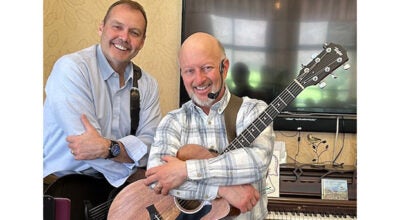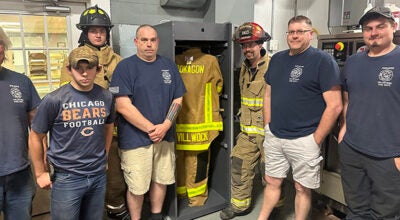Robotic bypass performed on Leversen
Published 10:12 am Tuesday, March 26, 2013
Winded while walking March 10, Dan Leversen went to the walk-in clinic the next morning, then across the street to Borgess-Lee Memorial Hospital for a blood work-up.
Dr. Theresa Kordish informed him he was having a heart attack.
“Next thing I know, an ambulance is taking me to Borgess in Kalamazoo,” he said Monday.
With severe blockage, he needed bypass surgery.
Instead of cracking his chest open, however, Dr. Jerry Pratt Wednesday morning proposed Leversen, 52, be first to undergo a robotic-assisted, minimally invasive bypass.
Pratt, a heart surgeon from the University of California Davis Medical Center in Sacramento, joined Borgess Heart Institute as medical director, thoracic surgery, last year. He is a highly decorated U.S. Air Force colonel who served surgical tours of duty in Iraq and Afghanistan.
Borgess Heart Institute brought open-heart surgery to Southwest Michigan in 1971.
Coronary artery disease is a condition in which plaque builds up, reducing blood flow to the heart muscle. Plaque can also increase likelihood of blood clots, which can further narrow or block blood flow. Angina (chest pain) occurs when an artery narrows and an area of the heart doesn’t receive enough oxygen-rich blood.
Coronary artery bypass graft (CABG) surgery allows surgeons to restore blood flow to the heart muscle using a section of artery or vein from another part of the patient’s body.
Surgeons re-route blood flow around the narrow or blocked artery. Conventional CABG surgery is considered major heart surgery and performed almost exclusively by cardiothoracic surgeons. It is one of the most effective treatment options for coronary artery disease, the most common form of heart disease.
Minimally invasive, robot-assisted CABG is a revolutionary procedure that lets a surgeon perform the operation through tiny incisions.
Using the da Vinci surgical system, the most advanced robotic system of its kind, a surgeon makes incisions one to two centimeters in length, then inserts small robotic arms and a camera, which provides the surgeon with a three-dimensional view of the heart magnified 10 times.
Sitting at a computer console, the surgeon’s hands control the robotic arms. Robotic arms mimic a surgeon’s hand movements, but allow for a greater range of motion and more precision.
The operation begins when the surgeon locates a healthy artery, usually a mammary artery.
“They wanted me for this because I’m ‘young’ and my heart is relatively strong. The whole idea behind this process is your heart’s still beating while they’re doing the procedure. The magic is the recovery time is amazingly quicker,” he said.
Leversen was walking within 36 hours of open-heart surgery.
“I knew it must be impressive,” he said, “because I can’t begin to tell you how many nurses and doctors came into the room to see what was going on. They had never seen it before. I was the only one of 46 patients in the ward up and walking before five to seven days. Sunday night, I was home after surgery Thursday. If you’re going to have work like this done, and you’re a basketball fan, it’s good to do it during the NCAA championship.”
“Borgess has one of the best cardiac care centers in the country. They rank right up there with Cleveland,” Leversen said he had learned. “When you’re in your 30s, 40s and 50s and drop dead of a heart attack, it’s because you don’t know what a heart attack is. You don’t correlate your body breaking down like that. When you’re in your 60s, 70s and 80s, you go see a doctor. I thought worst-case scenario, maybe I needed a stent. I watched (cardiologist Dr. J. Gary Gustafson) put a stent in on the video monitor. Seeing all the blood going to my heart was the coolest thing to see in the world as a patient. Twenty minutes, they were done. I don’t have to wait for a million stitches to heal or walk around with IV bottles all over me.
“The amazing part about the whole thing is the people,” he said. “Everyone, from people who clean the floors and brought food to my room, I felt like I was at a five-star hotel. It’s three weeks before you can think about getting back to a normal routine. They don’t want you outside unless it’s 50 degrees or warmer,” which meant missing his children, Adrian and Mary, in last weekend’s musical, “Disco Inferno.”
“I will never go back to my old ways of living,” Leversen said, patting his paunch. “If there’s nothing else I got out of this, I tell my friends and family to get a blood test, which picks up enzymes. People don’t go for preventive care, they do reactive care.”
Leversen and his wife, Stacy, a former school board member, moved to Dowagiac eight years ago from Chicagoland to operate the former Heartland dealership.
“The outpouring from this community. People are bringing us dinner and coming to the door with bags of fruit. My biggest shock is how many people care. I realized how lucky we are to have a facility like this in our backyard. We take the hospital for granted.”







